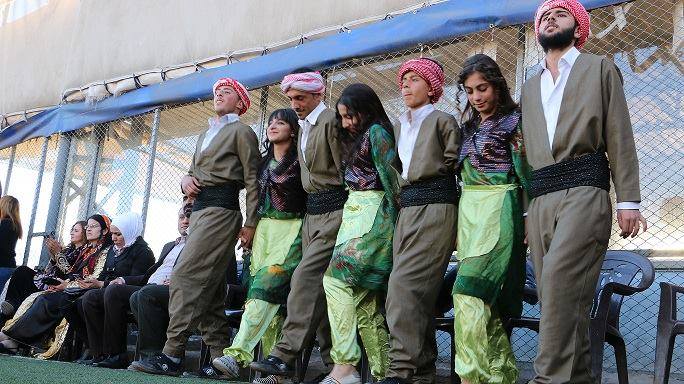Kurdish Youth Dance On

A new network of art, dance and drama groups is helping to brighten the lives of young Kurds in Syria.
The Kurdish Democratic Youth Union [KDYU] wants its members to participate in performing arts as a way of strengthening identity, boosting confidence and building youth leadership.
The largest group, called Siwan, was formed in the village of Amuda in February.
“The group has 29 members,” Amuda KDYU head Penkin Tatar told Damascus Bureau. “Fifteen of them are folk dancers, nine are theatre actors, and five are singers.
“All our members have been encouraged to join the group by their parents, who want to their children to escape the depressing reality they live in,” Tatar continued.
“And what better way to achieve this than join a music or dance group?”
The scheme is proving popular amongst villagers.

“I have always encouraged my grandchildren to join different Kurdish art groups,” Amuda resident Huda Salih told Damascus Bureau.
“So when I heard that the Kurdish Democratic Youth Union [KDYU] had launched a branch in our village Amuda, I insisted they join it.
“It’s very important that they interact with other students from their age groups, and also develop their talent and potential,” she said.
“When we formed the union, we noticed that many of those who joined it felt a sense of loss, so we decided to introduce a number of activities that would be both beneficial and entertaining for them,” explained KDYU head Roni Mohammed.
Previous KDYU initiatives include establishing women’s football teams for Kurdish players.
(See also Women Kick Up A Storm in Syrian Football)
The union’s art, dance and theatre groups now boast a diverse membership of boys and girls of different ages.
“We are trying to help create successful young leaders. All our members participate in dialogue, administration and leadership activities. They also choose the traditional songs and folklore dance routines they perform,” Mohammed told Damascus Bureau.
None of the groups have costumes yet, but they try to incorporate certain colours in their performances; red to symbolise the Kurdish struggle and black as a sign of identity and belonging.
KDYU secretary Hajir Hassan told Damascus Bureau that the union faced many challenges, such as ensuring their members’s security and psychological well being, as well as adapting to increasing rates of youth migration.
“Despite all these hardships, we continue to do our best to meet the aspirations and expectations of our youth,” Hassan said.
All performances are shared on the union’s Facebook page and the positive comments posted there have delighted the young performers, as well as the feedback their perfomances receive.
“We feel really appreciated when we perform and the audience applauds us,” said Javin, a member of the Deirak Buds children’s dance group.
“My mother and father are very happy with my performances, they always take photos of me so I can look back at them when I’m older.”
His troupe, which caters for boys and aged between 10 and 15, was formed in early 2016 by the Deirak branch of the KDYU.
Its head Daham Othman said that the group’s 18 members take part in three training sessions a week at the office of the Kurdish Women’s Union.
To ensure their safety, the union has arranged for a minibus to pick them up from their homes and take them back after training.
Othman hoped that his young performers would develop their skills to an extent that would allow them to perform at national events.
Elsewhere, in the town of Terpsibi, the Vianne troupe specialises in theatre and folk dance.
Formed by the Alyan branch of the KDYU in February, the six girls and seven boys are trained by coach Fayiz Rifai.
Alyan head Hozan Sheikhmus told Damascus Bureau that the group recently performed a play on how Syrians are remaining steadfast despite the conflict, which was warmly received by its audience.
In Qamihli’s Urkush troupe, “there is a healthy competition amongst members of the group who try to earn a permanent spot in a specific category,” said local KDYU head Shukri Abdel Rahman.
Set up in February, the group is made up of 17 male and female members who take part in drama, singing and dancing.
“We also have a number of strong vocalists, such as twin sisters Shereen and Nisreen Abdel Baqi and their brother Shafkar,” he said.
The initiative has even reached areas still affected by armed clashes.
In Hassakah, a group of youngsters created the Komajin group despite ongoing violence around the city.
“Members of the KDYU Hassakah branch were determined to form their own dance group,” coach Leen Nimat told Damascus Bureau.
“The Komajin group consists of 10 young members, to whom I teach folk dance and hip hop,” she said.
The reality of conflict is never far away, however.
Their special Nowruz perfomrance, celebrating the March 18-21 spring holiday, included a sketch honouring the victims of a massacre that happened on the eve of last year’s festival.
Shafan Ibrahim is the pseudonym of a Damascus Bureau contributor from Hassakah, Syria.
Read the Arabic version of this article here
